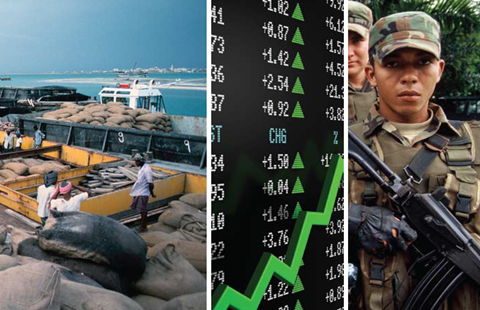Companies and their investors are paying increased attention to the challenges and opportunities of doing business in conflict-affected and high-risk areas.
These areas differ significantly from more stable operating environments and require companies and investors to take into consideration additional factors. Various tools have been developed to help companies implement responsible business practices in these sensitive areas, yet they still face many challenges. Two major difficulties have been the lack of agreement on what constitutes “responsible” business in conflict-affected and high-risk areas, and the practical challenges unique to such contexts.
The private sector and peace
The primary responsibility for peace, security and development rests with governments, but the private sector can make a meaningful contribution to stability and security in conflict-affected and high-risk areas. Commercial activities have direct and indirect positive impacts by creating job opportunities, generating revenues that advance economic development and recovery making sustainable investments in cities and towns, creating inclusive hiring policies that build good relations between ethnicities and communities, developing “bottom of the pyramid” business strategies and promoting best practices in the areas of human rights, labour, the environment and anticorruption. Business can also be a powerful incentive for bringing people together across national and cultural lines, creating relationships based on a shared sense of identity and purpose, overcoming differences that, in the wider society, are more difficult to surmount. These contributions can be made by companies of all forms: small and large, public and private, international and local.
Yet in some cases, companies may negatively impact their own operations and their activities may exacerbate conflict or instability – even if their intentions are for the best. One common pitfall is hiring or consulting with one group of local stakeholders while ignoring the rest, unintentionally benefiting one group over another which can foster grievances between communities. Wellmeaning social investment projects may undermine a government’s role in providing basic services. And poorly-trained security forces might use excessive force around company assets resulting in human rights abuses.
Such impacts can create reputational, operational, and financial risks for companies and investors. Engagement with companies operating in conflict-affected and high-risk areas can increase investors’ understanding of highly complex situations and access to information regarding companies’ activities, promote the development of good policies and risk mitigation strategies related to such activities, and encourage companies’ positive contributions to sustainable peace and development. When companies and investors are able to understand and take steps to address complex issues associated with such contexts, they can mitigate the risks and negative impacts posed to and/or by corporate activities, ensure long-term financial performance of business and play an important role in supporting peace and development.
The meaning of “conflict-affected” and “high-risk”
There is no single definition for the terms “conflict-affected” or “high risk” areas. This guide may be relevant for a variety of contexts, including countries, areas or regions:
That are not currently experiencing high levels of armed violence, but where political and social instability prevails, and a number of factors are present that make a future outbreak of violence more likely.
• In which there are serious concerns about abuses of human rights and political and civil liberties, but where violent conflict is not currently present.
• That are currently experiencing violent conflict, including civil wars, armed insurrections, inter-state wars and other types of organised violence.
• That are currently in transition from violent conflict to peace (these are sometimes referred to as ‘post-conflict’; however transition contexts remain highly volatile and at risk of falling back into violent conflict).
Companies are encouraged to:
- Develop policies and procedures for engagement with investors and be open to discussing concerns outlined within this guidance.
- Make reasonable efforts to disclose information that will enhance investors’ understanding of business activity in a timely manner and taking account of legal and commercial considerations.uidance at the earliest stages of their operations and throughout, especially during their initial consideration of investment.
- Use their annual “Communication on Progress” to report on the implementation of this guidance and make sure it receives wide circulation among the stakeholders.
- Ensure the involvement of their Boards and senior management on these issues to demonstrate high-level concern for the challenges of operating in such contexts.
- Join a Global Compact Local Network in an operational area. These are countryspecific, multi-stakeholder platforms which can have a multiplying effect on a company’s good intentions. Actions are often more effective when taken collectively and in a multi-stakeholder context.
Investors are encouraged to:
- Make reasonable efforts to assess all public information when engaging companies.
- Make reference to this guidance during dialogues with investee companies with operations or interests in conflict-affected or high-risk areas.
- Review the company’s annual Communication on Progress to access relevant information about a company’s implementation efforts.
- Improve communications between specialist Economic, Social and Governance (ESG) analysts and fund managers in relation to conflict-related issues discussed with companies. Provide constructive feedback to companies on their communications with investors.
- Explain how the information provided by companies will be used in the investment process (selection of sectors and individual assets, basis for ownership decisions, etc).
- Be prepared to act collectively with other investors under appropriate circumstances.












